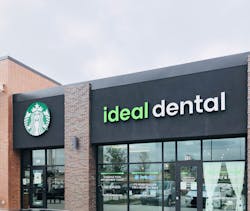The beginning
My dream, like that of many dentists, was to graduate from dental school and hopefully own my own practice one day. I looked forward to a four-day workweek with Fridays spent on the golf course and in the community I served. Folks would know me by name as I ran into them at the local coffee shop or grocery store.
The year was 2005, and I was moving back to Dallas, Texas, after completing my dental education at the Tufts School of Dental Medicine in Boston. I quickly realized that my dream was just that. It seemed that every suburb in Dallas and the surrounding areas already had at least four dentists at every intersection. These offices consisted of both private practices and large organizations. By nature, dentistry is both a mature and competitive industry. And yet, despite barely being out of school and still honing my clinical skills, I already wanted to own a practice.
I found one in a beautiful part of town that generated approximately $1 million in annual revenue, and I thought this was it. Getting the loan approved was easy enough, despite almost $500,000 of student loan debt to my name. As I was waiting on the closing process, I decided to shadow the selling dentist, only to learn from his front office that he had just built a brand-new facility a mile away and moved several of his patients to this new location.
I was a young, naïve dentist with a passion for our profession but very little understanding of the business implications in the paperwork I was signing. As it turned out, that deal did not go through, and that was one of the best things to ever happen in my dental career. The experience forced me to take a step back and realize that I was rushing into obstacles that I was ill-equipped to tackle. During the next few years, I worked as an associate and acquired the necessary clinical skills and bedside manner to make a great dentist and build trust and lasting relationships with my patients.
During this time, I became acutely aware of an under met need in dentistry—to be more accommodating to patients. As dentists, we often perceive our patients' desires through the lens of our convenience as providers. This includes the days and hours we work, how we refer out treatment, or how we reschedule patients . . . all practices that would lead to certain failure in most businesses but are somehow widely accepted in the dental field.
I also observed the pharmacy model and noticed how the more prominent groups are dominant in all primary markets. They have the best real estate with excellent visibility, parking, and access. What’s more, pharmacies are open seven days a week, accept our insurance, and have drive-through facilities. In addition to getting prescriptions filled, a customer can also pick up some milk and bread during their visit. In short, these pharmacies seemingly do it all.
I believed then, and still do, that the dental industry is ripe for disruption. Exceptional clinical quality is obviously expected, but any dentist who provides superior customer service on top of that will dominate the space. As these realizations took root, I was ready to own a practice and build something new: a practice that’s centered entirely around the satisfaction of our “guests” (aka our patients), prioritizing their needs while building an internal culture unlike any other. From this, the vision for building the Ideal Dental brand was born.
In December 2008, I opened my first start-up practice and my first acquisition two weeks apart. This was not by design but rather due to the start-up being delayed by several months. Needless to say, the timing was a bit of a challenge, but I was able to learn firsthand, and in real time, the differences between the two practice models. I realized that, although it’s a slower process, in order to foster culture and create a standardized business and clinical system, I would have to build from the ground up.
The early years were tough. I was working six days a week and slowly adding a couple of practices a year to the group. Some were opportunistic, but most were intentional. We staked out retail centers in newly developed areas and built offices that were 100% standardized, and this was key. The look, feel, color, smell, all the way to how we answered the phone, were all uniform. I was creating the “Starbucks of dentistry.”
Early on, I was working during the day as a practicing dentist and, at night, wearing my CEO hat to ensure the business and clinical protocols were happening in every office. Today, we have a clinical board that consists of more than 25 dentists who perform randomized chart audits and help mentor dentists as needed. We also utilize third parties to conduct audits to ensure that every procedure is done at the highest clinical level. This includes procedures such as crown remake percentage, guest wait times, and other customer-level activities. The goal is to systematically measure clinical outcomes and customer satisfaction.
Going from the first few offices to the next 10 meant that I would have to reduce my chair time to help support the growing business needs. We slowly started centralizing functions such as billing, accounting, and revenue cycle management to ensure better controls. More importantly, this also allowed the office staff and dentists to focus their entire time on taking care of our guests. Now, every 10 to 15 locations present a new set of challenges and further investment of human and financial capital to keep growing with that same customer-first focus.
Over time, we built our clinical training playbooks for every position, primarily focusing on customer service excellence. We brought in speakers from Disney, Southwest Airlines, and other industry leaders to share their stories and best practices. But most importantly, we built an organization where our staff could develop and grow. The opportunity to allow individuals who began their careers, for example, as a front office associate to move into an office manager position, and then into a regional director, has been the most rewarding part of my journey.
I feel that every dentist is an entrepreneur. However, we oftentimes limit ourselves to thinking we are only clinicians. In an environment where consolidation is on the rise, it is more important than ever for the next generation of dental leaders to rise and lead the charge.
Although we are in the dental business, most of the large dental groups are founded and led by nondentists. It is upon us to safeguard our great profession. I am proud to say that DECA Dental Group, which grew from the flagship brand, Ideal Dental, is founded and led by clinicians. Clinical outcomes are at the core of everything we do. We are dentists leading dentists.
Here at DECA Dental Group, we are on a quest to uphold the high standards set in dentistry, exceed guest expectations at every visit, and create the Starbucks of dentistry.
Editor's note: This article appeared in the October 2021 print edition of Dental Economics.
Sulman Ahmed, DMD, is the founder and CEO of DECA Dental Group and the company’s flagship brand, Ideal Dental. Dr. Ahmed has achieved several honors and awards, including being named 2017 EY Entrepreneur of the Year and Glassdoor’s Top CEOs list for 2021, with a 98% approval rating. Dr. Ahmed obtained his DMD from the Tufts University School of Dental Medicine in Boston and he currently serves on their Board of Advisors.










